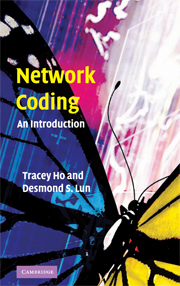4 - Network Coding in Lossy Networks
Published online by Cambridge University Press: 06 July 2010
Summary
In this chapter, we discuss the use of network coding, particularly random linear network coding, in lossy networks with packet erasures. The main result that we establish is that random linear network coding achieves the capacity of a single connection (unicast or multicast) in a given coding subgraph, i.e., by efficiently providing robustness, random linear network coding allows a connection to be established at the maximum throughput that is possible in a given coding subgraph.
Throughout this chapter, we assume that a coding subgraph is given; we address the problem of subgraph selection in Chapter 5, where we also discuss whether separating coding and subgraph selection is optimal. The lossy coding subgraphs we consider here are applicable to various types of network, including multi–hop wireless networks and peer–to–peer networks. In the latter case, losses are not caused so much by unreliable links, but rather by unreliable nodes that intermittently join and leave the network.
We model coding subgraphs using the time–expanded subgraphs described in Section 1.3. Recall that a time–expanded subgraph describes the times and locations at which packet injections and receptions occur. Since a coding subgraph specifies only to the times at which packet injections occur, a time–expanded subgraph is in fact an element in the random ensemble of a coding subgraph. A time–expanded subgraph is shown in Figure 4.1.
- Type
- Chapter
- Information
- Network CodingAn Introduction, pp. 65 - 85Publisher: Cambridge University PressPrint publication year: 2008



